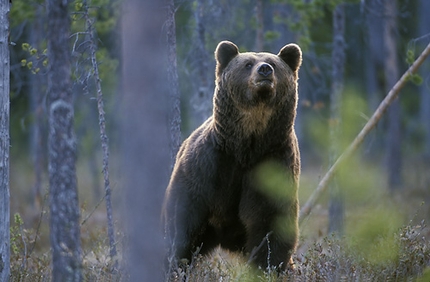Grizzly (brown) bear habitat is considerably varied. Brown bears may occupy areas of 100 to 150 square miles and range from desert and prairie to forest and alpine extremes. The areas must provide enough food during the 5 to 7 months in which they feed to meet their protein, energy, and other nutritional requirements for reproduction, breeding, and denning. Grizzly bears often travel long distances to reach seasonally abundant food sources such as salmon streams, burned areas with large berry crops, and lush lowlands.
Denning habitats may be a limiting factor in brown bear survival. Grizzly bears seek and use denning areas only at high elevations (above 6,000 feet), where there are deep soils for digging, steep slopes, vegetative cover for roof support, and isolation from other bears or people. Since grizzlies select and build their dens in late September, when their sensitivity to danger is still very high, even minor disturbances may deter the bears from using the best sites. Unfortunately, the habitat types bears choose in September are scarce, and human recreational use of the same high-elevation areas is increasing.
Travel corridors connecting large areas of grizzly habitat to individual home ranges are critical for maintaining grizzly populations. Adequate cover is also needed to provide free movement within their range without detection by humans. The land uses with the greatest impact on bear habitats and populations include road development, mining, clear-cut logging, and real estate development.
Coastal brown bears use totally different habitats than the interior grizzly. They establish home ranges along coastal plains and salmon rivers where they feed on grasses, sedges, forbs, and fish. While the fishing brown bears may use very small ranges for extended periods, almost all bears make occasional, long-distance movements to other areas where food is abundant. This far-ranging behavior often leads to unexpected human-bear conflicts far from typical brown bear range.
Social factors within bear populations influence habitat value—the removal of one dominant bear or the sudden deaths of several bears can cause the remaining bears to greatly alter their habitat-use patterns. Such changes occur simply because the social hierarchy within bear populations typically gives large bears dominance over the smaller ones, and each bear uses its range based on its relationship to the other bears in the area.
